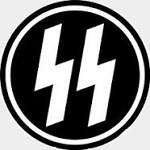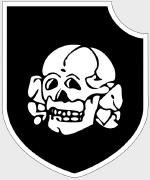Dragon DRR63252 German Mid Production Sd. Kfz. 142 Sturmgeschutz III Ausf. G Assault Gun with Schurzen Side Skirts - 3.SS Panzer Division "Totenkopf", Kursk, Russia, 1943 (1:72 Scale)
"We must do everything we can to promote anti-tank defense, and work just as hard to guarantee successful counter-attacks through the instrument of powerful tank forces of our own."
- Major-General Heinz Guderian, "Achtung Panzer!"
 The Sturmgeschutz III (StuG III) assault gun was Germany's most-produced armored fighting vehicle during World War II. It was built on the chassis of the proven Panzer III tank, replacing the turret with an armored, fixed superstructure mounting a more powerful gun. Initially intended as a mobile assault gun for direct-fire support for infantry, the StuG III was continually modified, and much like the later Jagdpanzer, was widely employed as a tank destroyer.
The Sturmgeschutz III (StuG III) assault gun was Germany's most-produced armored fighting vehicle during World War II. It was built on the chassis of the proven Panzer III tank, replacing the turret with an armored, fixed superstructure mounting a more powerful gun. Initially intended as a mobile assault gun for direct-fire support for infantry, the StuG III was continually modified, and much like the later Jagdpanzer, was widely employed as a tank destroyer.
The Sturmgeschutz originated from German experiences in World War I, when it was discovered that, during the offensives on the Western Front, the infantry lacked the means to effectively engage fortifications. The artillery of the time was heavy and not mobile enough to keep up with the advancing infantry to destroy bunkers, pillboxes, and other minor fortifications with direct fire. Although the problem was well known in the German army, it was General Erich von Manstein who is considered the father of the Sturmartillerie ("assault artillery"). This is because the initial proposal was from (then) Colonel Erich von Manstein and submitted to General Ludwig Beck in 1935, suggesting that Sturmartillerie units should be used in a direct-fire support role for infantry divisions. On June 15th, 1936, Daimler-Benz AG received an order to develop an armored infantry support vehicle capable of mounting a 75 mm (2.95 in) calibre artillery piece. The gun mount's fixed, fully integrated casemate superstructure was to allow a limited traverse of a minimum of 25 degrees and provide overhead protection for the crew. The height of the vehicle was not to exceed that of the average soldier.
Daimler-Benz AG used the chassis and running gear of its recently designed Panzer III medium tank as a basis for the new vehicle. Prototype manufacture was passed over to Alkett, which produced five prototypes in 1937 on Panzer III Ausf. B chassis. These prototypes featured a mild steel superstructure and Krupp's short-barrelled, howitzer-like in appearance, 7.5 cm StuK 37 L/24 cannon. Production vehicles with this gun were known as Gepanzerter Selbstfahrlafette fur Sturmgeschutz 7.5 cm Kanone Ausfuhrung A to D (Sd.Kfz.142).
While the StuG was considered self-propelled artillery, it was not initially clear which land combat arm of the German Army would handle the new weapon. The Panzerwaffe (armored corps), the natural user of tracked fighting vehicles, had no resources to spare for the formation of StuG units, and neither did the infantry branch. It was agreed, after a discussion, it would best be employed as part of the artillery arm.
Pictured here is a 1:72 scale replica of a German Sd. Kfz. 142 Sturmgeschutz III Ausf. G assault gun with Schurzen side armor that was attached to the 3.SS Panzer Division "Totenkopf", then deployed to Kursk, Russia, during the summer of 1943.
Now in stock!
Dimensions:
Length: 3-1/2-inches
Width: 1-1/2-inches
Release Date: September 2024
 Historical Account: "Death's Head" - "Totenkopf" (Plural: Totenkopfe) is the German word for "death head" or "death's head" and is used to describe a military insignia featuring a skull above crossed bones. It is distinguished from the similar traditions of the skull and crossbones and the Jolly Roger by the positioning of the bones directly behind the skull. For a long time in widespread use in several countries, its association with aspects of Nazi Germany has led to its decline.
Historical Account: "Death's Head" - "Totenkopf" (Plural: Totenkopfe) is the German word for "death head" or "death's head" and is used to describe a military insignia featuring a skull above crossed bones. It is distinguished from the similar traditions of the skull and crossbones and the Jolly Roger by the positioning of the bones directly behind the skull. For a long time in widespread use in several countries, its association with aspects of Nazi Germany has led to its decline.
In the early days of the NSDAP, Julius Schreck, the leader of the Stabswache (Adolf Hitler's bodyguard unit), adopted the Totenkopf for his unit.
This later grew into the Schutzstaffel (SS), which continued to use the Totenkopf as insignia throughout their brief history. As they had done with the Swastika, the Nazis simply adopted the Totenkopf from the historical tradition and used it for their own purposes, leaving it marked with a stigma that has continued to the present.
It is important to note that the SS "Death's Head" symbol is markedly different from the original German (Prussian) "Totenkopf", the original being much more "cartoonlike" in appearance, with the SS version appearing more "realistic." In short, they are two very different symbols.









